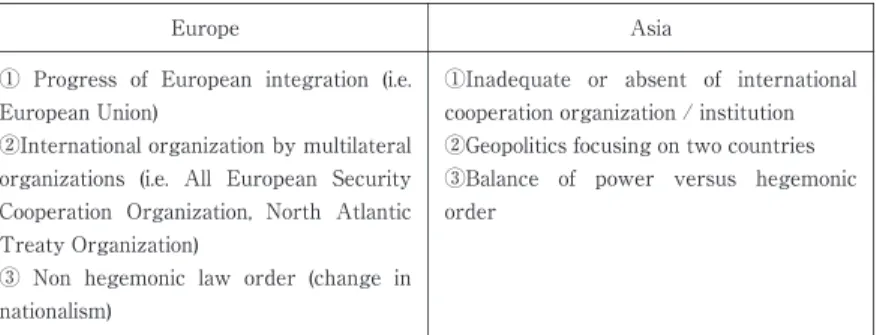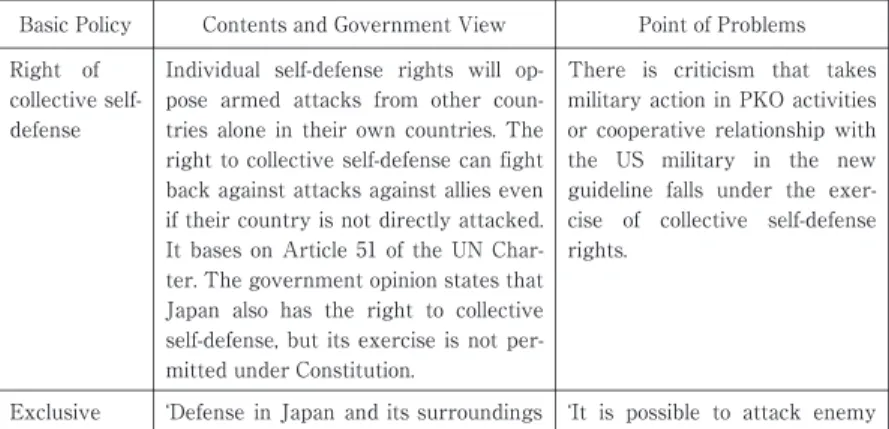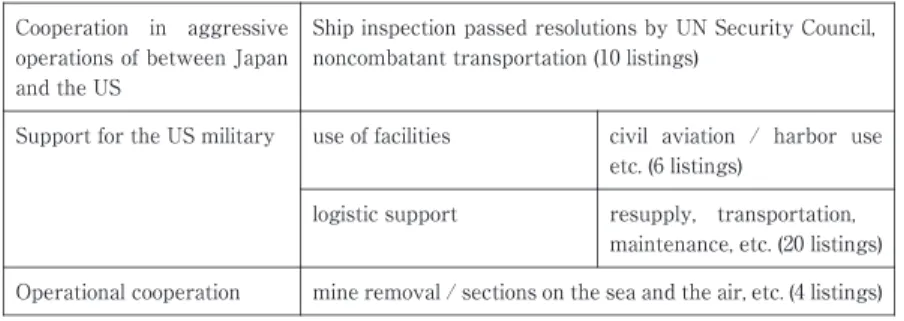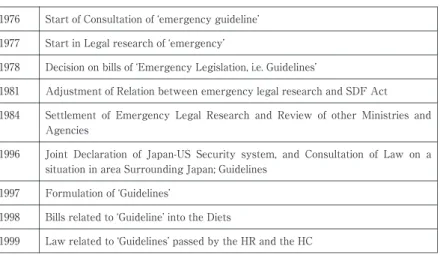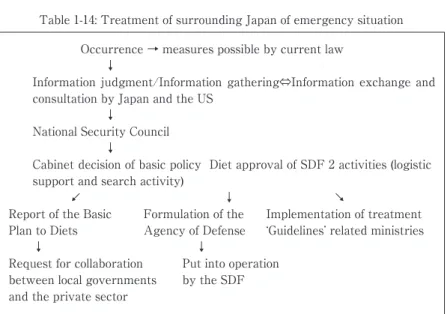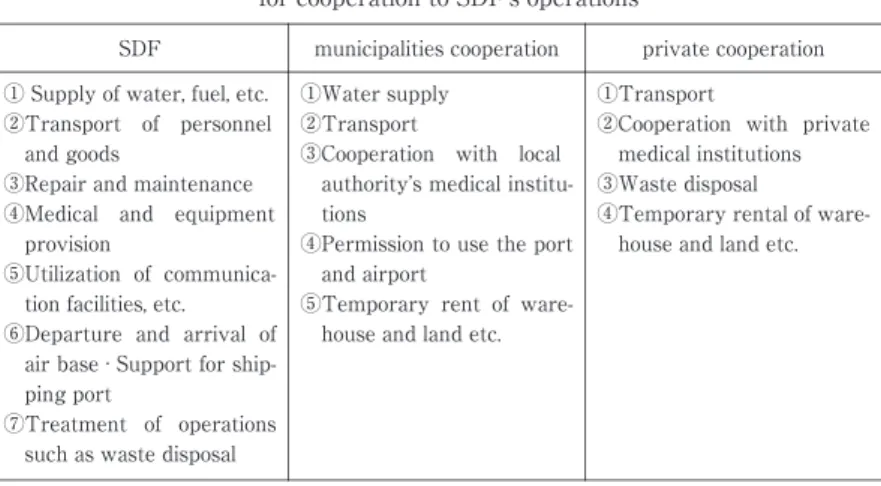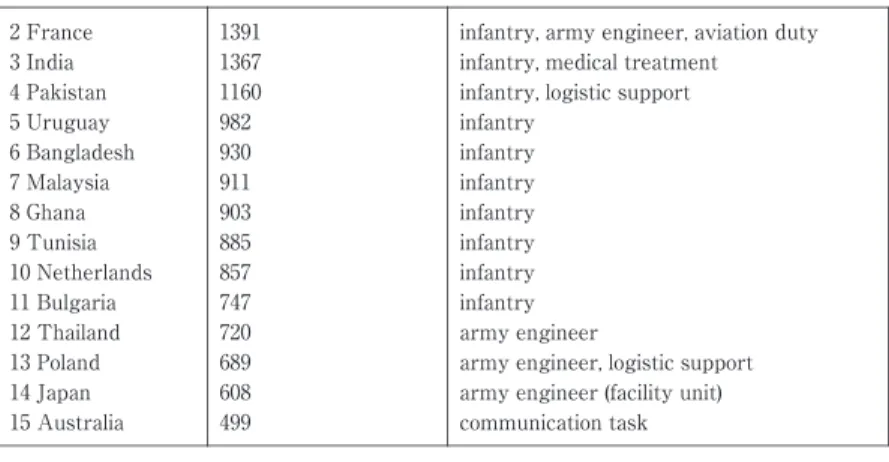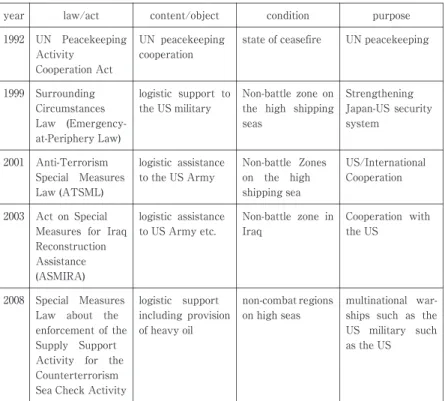《論 説》
Japan’
sSecuri
tyPol
i
cyi
nPostwar
andJapanesePeopl
e’
sVal
ue
― Processi
nEstabl
i
shment,Transf
ormati
on,and
Expansi
onoftheJapan-
USSecuri
tySystem ―
MasaoFuruta
Content Preface Introduction
Part1 PostwarhistoryofsecurityinJapan
Part2 The transition ofinternationalcontribution and securityinJapansincetheendofColdWar Part3 InternationalpoliticstransformingaftertheCold
WarandJapanesesecuritypolicy
Part4 Japanacceptingtherightsofcollectiveself-defense Part5 Japanesepeople’sviewofsecurityaftertheSecond
WorldWar
Part6 Re-examinationofsecurityininternationalpolitics Conclusion
Appendix Theoreticalre-considerationonbalanceogpower Reference
Abbreviations
ABM Anti-BallisticMissile
ACSA AcquisitionandCross-ServicingAgreement ADB AsianDevelopmentBank
ADMM ASEANDefenseMinister’sMeeting AIIB AsianInfrastructureInvestmentBank
AMF AsianMonetaryFund
ANZUS SecurityTreatybetweenAustralia,New ZealandandtheUnited StatesofAmerica
APEC Asia-PacificEconomicCooperation ASCO SpecialActionCommitteeonOkinawa ASEAN AssociationofSoutheastNations ASEM Asia-EuropeMeeting
ASMIRA ActonSpecialMeasuresforIraqReconstructionAssistance ATSML Anti-Terrorism SpecialMeasureLaw
AWACS AirborneWarningandControlSystem BMD BallisticMissileDefense
CBM Confidence-BuildingMeasures COC CodeofConduct
CSF CoastalSafetyForce
CTBT ComprehensiveNuclearTestBanTreaty DC DefenseCouncil
DH DefenseIntelligenceHeadquarters DMZ DemilitarizedZone
DOD USDevelopmentofDefense DPJ DemocraticPartyofJapan
DPRK DemocraticPeople’sRepublicofKorea(NorthKorea) DSG DefenseStrategicGuidance
DSP DemocraticSocialistParty EASR EastAsiaStrategyReport GDP GrossDomesticProduct
Guideline GuidelineforJapan-USDefenseCooperation HC HouseofCouncilors(theUpperHouse) HR HouseofRepresentative(theLowerHouse) ICBM IntercontinentalBallisticMissile
IRBM Intermediate-RangeBallisticMissile JASDF JapanAirSelf-DefenseForce JCG JapanCoastGuard
JFEO JapanFederationofEconomicOrganizations JGSDF JapanGroundSDF
JMSDF JapanMaritimeSelf-DefenseForce
KEDO KoreanPeninsulaEnergyDevelopmentOrganization
ReconstructionAssistance LDP LiberalDemocraticParty MD MissileDefense
MEF MarineExpeditionaryForce MEU MarineExpeditionaryUnit MOD MinistryofDefense
MOU Memorandum ofUnderstanding MSA MutualDefenseAgreement NATO NorthAtlanticTreatyOrganization NDPO NationalDefenseProgram Outline NPR NationalPoliceReserve
NSC NationalSecurityCouncil NTP NuclearNonproliferationTreaty ODA OfficialDevelopmentAssistance
OECD OrganizationforEconomicCo-operationandDevelopment PKO PeaceKeepingOperation
PKF PeaceKeepingForce PPH PowerProjectionHub PRC People’sRepublicofChina PSI ProliferationSecurityInitiative PTBT PartialTestBanTreaty ROC RepublicofChina(Taiwan) ROK RepublicofKorea(SouthKorea) QDR QuadrennialDefenseReview SACO Japan-USSpecialActionCommittee SALTI StrategicArmsLimitationTalk SCO ShanghaiCooperationOrganization SDCF SecurityandDefenseCooperationForum SDF Self-DefenseForce
SPJ SocialistPartyofJapan SDP SocialDemocraticParty SOC StandardOperationCode START StrategicArmsReductionTreaty THAAD TheaterHighAltitudeAreaDefense TMD TheaterMissileDefense
UK UnitedKingdom UN UnitedNations
UNCLOS UNConventionontheLawoftheSea UNDOF UNDisengagementObserverForce UNDP UNDevelopmentProgram
UNHCR UNHighCommissionerforRefugees UNPACA UNPeacekeepingActivitiesCooperationAct UNTAC UNTransitionalAuthorityinCambodia UNTSO UNTruceSupervisionOrganization US UnitedStatesofAmerica
USFJ USForceJapan
Pref
ace
InJuly2014theAbegovernmentdecidedamajorpolicychangeover Japan’ssecurityaftertheSecondWorldWar.TheLDPandtheKomei( ) tou oftherulingpartieschangedtheinterpretationofConstitutionfrom the past,andagreedtoexpandtherangeofSDF’sactivities.Thedecisionis currentlyassociatedwithdealingwiththedevelopmentoftheDPRK’s nuclearbombandlong-rangemissiles.In2017theAbeCabinetpoststhe defenseexpenditureof2018tothemaximum,andpurchasesUS-made defenseequipment.JapanisacceleratingitsrelianceontheUS.Wecan seethethreepointsinthedecision.
Thefirstiscopingwithterrorists,rescuingJapanesepeopleoverseas, expandingPKOandhumanitarianaidactivity.
Thesecondallowsthelimitedexerciseofcollectiveself-defenserights whichwasconsideredunconstitutionalsincethen.
ThethirdisthattheSDFaggressivelysupportsthebackwardsupport offoreignarmyactivities.
ThecurrentLDPwishestoexpandtheactivitiesofSDFasmuchas possible underthe existing Constitution (oramending Constitution). HowevertheMinistryofDefenseandtheSDFexpecttolimittoactivities withinthescopeofpresentConstitutionandtheSDF Law.Inother wordstheywanttoabidebyconstitutionalinterpretationofthepast.
Sowhatisthemostimportantcontroversy?Itisaquestionaboutthe rightofcollective self-defense.In addition to the execution ofthe conventionalindividualself-defenseright,PrimeMinisterAbesaid,“An armed attack on the US closely related to Japan was made,this threatenedtheexistenceofourcountry,andhow tointerpretthatthere
isadangerthatrightswillbeoverturnedfrom theroot”.Putanother way,Japanwillactivatetherightofself-defenseiftheUS,analliancefor Japan,isdirectlyconnectedtoasituationthatthreatenstheexistenceof Japan when itissubjected toan armed attack.Changesin Japan’s securitypolicycanalsobeconsideredasthehistoryoftheincreasein Japan’scooperationwiththeUSsincetheendofSecondWorldWarand theconclusionoftheJapan-USSecurityTreaty.Iwouldliketopointout onlytwoquestionshere.
Onequestionisthedefinitionofa‘newsituation’ora‘changingreality’. Ifthegovernmentdeclaresthat‘thissituationorarealityisathreatto theexistenceofourcountry’,itwillbepossibletoexercisetherightof collectiveself-defense.Thatmeasureadmitsthegovernment’sdiscretion toowidely.Itscontrolrequiresclarificationtomaketheciviliancontrolby thebothDietsfunction.ConventionallytheJapan-USSecurityTreatyhas beenappliedtothenorthofthePhilippinesgeopolitically.Thechangesin governmentpolicyhaveexpandedthegeographicalrange.
Anotherquestionistheestablishmentofpermanentlaw concerning dispatchofSDFoverseas.Japancanpositivelycarryoutbackwardand legislativesupportsofforeign(mainlytheUS)troopsabroad.Constitution prohibitswarastheinvocationofnationalrights.Doesthegovernment explain the contradiction between Constitution and government’s securitypoliciesinthesameway?Willsuchlawsbecontrolmeasures abroad?
TwopointswillaltertheJapan-USsecuritysystem sofar.Thechange oftheJapanesegovernmentin2015isnotwhatbegannow.Thepostwar Japan’ssecuritypolicyhasconvertedinaccordancewithchangesinthe internationalenvironmentand relationsbetween the two countries.
Japan’ssecuritypolicyisthehistoryofrepetitionofresponsefrom Japan inresponsetotherequestforincreasedcooperationfrom theUSto Japan,andinresponsethereto.HoweverJapan’ssecuritypolicyhasnot progressedasexpectedbythebothgovernmentsofJapanandtheUS. Followingthewarexperience,JapanesepeopleaftertheSecondWorld Warhaveacquirednormsthathavenotexistedbeforethewar.Itis ‘pacifism’and‘anti-militarism’.Thesenormsarecompletelydifferentfrom the‘militantcharacter’ofJapanesepeoplebeforetheSecondWorldWar, andhavetakencontrolinthesecuritypolicyaccordingto‘norms’inthe postwar.
InthispaperIwillinvestigatethetransitionofJapan’ssecuritypolicy aftertheSecond World Warand thevaluesoftheJapanesepeople affectingpolicy.Iwilldealwiththefollowingissuesinthispaper.
Part1describesthetransitionofJapan’ssecuritypolicysincetheend ofSecondWorldWar.BothgovernmentsofJapanandtheUShave soughttosurvive,strengthenandexpandtheJapan-USSecurityTreaty evenaftertheendofColdWarfrom theestablishmentoftheJapan-US securityarrangementsduringtheColdWar.Inparticularthenatureof theJapan-USalliancehasbeentransformedateachstagefrom requests oftheUStoresponsesofJapan.
In Part2 after the end ofCold War,Japan became proactive international contributions from the international community. Traditionally the Japanese governmentshave contributed mainly to economiccooperationtooverseas,butlatelytheSDFhasbeendispatched overseasandhasbeenactive.Thispolicyisaview thatassertsthatitis aso-called‘normalstate’bytherealists.
politicshaschanged greatly.Weshould pay attention tochangesin circumstancesofinternationalpoliticsinthebeginningof21century,and mustcarefully investigatewhetherJapan hasresponded them.This confirmation willstrengthen the LPD’s ‘realistic’security policy of JapanesegovernmentsinPart4,andwillbeanecessaryconditionto considertheapproachtotheUSblockfurther.
InPart4theJapanesegovernmentshaveconventionallyjudgedthe righttocollectiveself-defenseasunconstitutional.However,in2014,the Abe government declared the rights of collective self-defense constitutional,andfurtherstrengthensactivecooperationwithbilateral alliancewiththeUS.
Inthefollowingfrom Part1toPart4wewouldliketoexaminepostwar historyofsecuritybythetwoperspectives.Iconsiderhow thepolitical cultureandviewofJapanesepeopleaffectthesecuritypolicybytheLDP governmentsinthepostwarperiodinPart5.InadditionIthinkaboutthe problem ofrealistsecurityinPart6.
Inmostofelectionsafterthewar,despitethefactthattheLDPchosen bytheelectorateislocatedatthegovernmentparty,thepeoplebasically support the government’s economic policy,but the conservative politician’ssecuritypolicyisnotnecessarilyagreedwiththepeople’s view.Whyisthatcircumstance?Itmayrelatetotherealisticorientation oftheLDP in internationalrelations.Iwillclarify thissituation and relationship.
InPart5how havetheJapanesepeopleunderstoodJapan’ssecurity policy sincetheSecond World War?They haveinstitutionalized the normsof‘pacifism’and‘anti-militarism’learnedbythewarexperience anddefeatofSecondWorldWar.Theseculturalnormshaveconstrained
thesecuritypolicyoftheLDPgovernments.Iarguethatthevaluesofthe Japanesepeoplehaveinfluenced theJapanesegovernments’security policywithreferencetotheargumentofKatzenstein[cf.Katzenstein,1996].
HoweverIwouldliketoarguemoreaboutthemotivesofthevalueof Japanesepeoplehedoesnotpayattentionto.
InPart6wehavetobeawareofambiguityaboutsafety,andherewe consider the problem in conservative’s realism.This theoretical examination willverify theideathatformsthebasisofthepresent Japan’ssecuritypolicy.InparticularIwouldliketoreview realism in internationalpoliticaltheoryandrealitypolitics.
Finally,inConclusion,assummaryandthesisofthispaper,weare confidentthatinstitutionsandnormswillinfluencethebilateralsecurity policyandregimeofJapanandtheUS.
Realism tendstobelinkedwithtraditionalpolicyinthebalanceof power.Itis‘hardbalancing’whichisoneofthetheoriessomerealistsand detterrentistsbelieve.Isthis‘hardbalancing’applicabletothecurrent internationalpoliticalsituation surrounding Japan? Iwould like to proposecontemporarypowerequilibrium asaprincipleofsecuritypolicy asarevisionofbalanceofpower.Iwillre-considerthistheoryinthe Appendix.Itis‘softbalancing’.Itwillbeconsideredthatthepolicybased onthistheoryisaneffectivemeansinthecurrentsecurityenvironment.
Introducti
on
1 Japanintheeraofpost-ColdWar
Intheearly1990speopleintheworldwereskepticalattheendofthe ColdWar[cf.TheEconomist,January8,1994:19-21;TheEconomist,July16.2005:25-27].
Wegraduallyconfirm thattheColdWarhasendeddifferentlyfrom presentsituationandresponse.Howeverinachangingsituationafterthe ColdWartheworldisfacinganuncertainfuture.Thereasonwhythe post-ColdWareraisuncertainisalsothedifferencebetweenEuropeand Asia after the Cold War.Although itis a cognitive disparity to internationalpoliticsaftertheColdWar,ifcontrastingthedifferencesof theinternationalorderiscompared,thefollowingcontrastingappearance isdrawn[cf.Oka,1958:16-50].
Internationalpoliticsisanalyzedintwoviews.Oneofthem isa‘viewof cycle’.Itisbased on a‘system ofpower’.TheGreatPowershave generatedandchangedinhistoryofbattles.Inotherwordstheworld politicsisapowerpolitics.Theotherisa‘structuraltheory’.Thisview thinksofthestructuralchangeinbuildingacommonsecurityinthe
Table1-1:Post-ColdWarsituationinEuropeandAsia
Asia Europe
①Inadequate or absent ofinternational cooperationorganization/institution ②Geopoliticsfocusingontwocountries ③Balance of power versus hegemonic order
① ProgressofEuropean integration (i.e. EuropeanUnion)
②Internationalorganizationbymultilateral organizations (i.e.AllEuropean Security Cooperation Organization,North Atlantic TreatyOrganization)
③ Non hegemoniclaw order(changein nationalism)
trendofmultination,democratizationandinternationalization.Thelatter pursuetheframeworkofmultilateralcooperation(seeTable1-1).
ForexamplethePRC’sbehaviorislookingatinternationalrelations withtheideaoftheColdWar-likebalanceofpower.ThePRCconfirms thatfirstly following the collapse ofthe USSR,strengthening self -confidencewiththeestablishmentoftheCommonwealthofIndependent State(CIS),secondlyprovidingtheopposingpowertotheUSbytheSCO, thirdlytryingtoadjusttherelationshipofpowerbygeopoliticalbalance, andfourthlythereexistsrecognitionthatmaintainsthebalanceofpower intheinternationalpoliticsandispositionedatitscenter.Inrecentyears thePRChasgreatlyenhancedthenavalstrengthandthesurrounding countriesposeathreat.Itsrangeofactivityextendsoverseaalongthe coastofthePRCtotheSouthChinaSeafrom thewesternPacific.Atthat time,therewasalsoacasewhereahelicopterofthePRC armygets abnormally close to the MSDF destroyer who was in charge of monitoring.
InthissituationasenseofcrisisthatcoulddepriveJapanofterritorial rightshasdevelopedaroundJapan.Japanlaunchedstrengtheningthe defenseoftheSenkakuIslandsattheendof2010aspartofanew‘ Japan-USdefenseoperationguidelines’concretelyincludedanincreaseinthe deploymentofSDFtroopstotheNanseiIslands(thesouthwestislandsof Japan)andthedefenseofremoteislandsinJapan.
ThePRCnervouslydisturbssuchmovementoftheJapanandhasa stronginterestinthecontentsofthe‘GuidelineforJapan-USDefense Cooperation(‘Guideline’)’betweenJapanandtheUS.Itisundesirablefor theinternationalcommunity tobeantagonisticbetween theworld’s secondandthirdlargesteconomies,andalsointheregionofthesame
EastAsia.ItisnodoubtthatJapanandthePRCareoneofthemost importantpartnersofeachother.ThePRCalsothinkswithJapan“Ifyou competeagainsteachotherandyougetalongyouwillbenefitjointly,you gethurteachother”.ThePRCwillmaintainitsstanceofemphasizing strategicreciprocityrelationswithJapan.Japanmustpositivelyappeal thenecessityofconfidencebuildingmeasures.
TheapproachtothistaskspecifiesthepolicyofJapanesediplomacy. Japanmayhavemoreactiveinvolvementwithmultilateralinternational organizations(i.e.theUN).Ofcoursetherealityisnotalwaysexactlythe case.Inotherwordsasdealtwithinthispaper,Japanhasprioritized safetyandpeacecenteredonthebilateralrelationswithUS(seeTable1-2).
Regardlessofchangesin theinternationalenvironmentsince1960, Japan’spro-theUSlinehasnotchangedthefollowingfourfactors[Asai, 1989:10]( ).
FirstlytheJapan-USsecuritysystem reliesontheUSmilitaryfor Japan’ssecurity.
SecondlytheJapan-USsecuritysystem activelysupportstheglobal strategyoftheUS.
Thirdly the Japan-US security system supportsthe US policy in internationalrelations,and plays a complementary role for its implementation.
Fourthly theJapan-US security system propsup theinternational leadershipoftheUSasthehegemonicpositionoftheWesternside. DoestheJapan-US allianceaftertheSecond World Wartruly fall basicallyinlinewiththenationalinterestsofJapan?How shouldthe
bilateralrelationsbeassessed?
Iwouldliketoargueaboutthe‘safetyandpeace’inpostwarJapan.
ContentsofJapan-U.S.Relationsoverthesecuritysystem Classification by
period
PrimeMinisterYoshidaconcludedwithlightarmedstaffandUS militarypresenceintheUSre-armedrequest.Japanwas‘expected tobegraduallyresponsiblefordefendingitsowncountry’,andin 1952 the NationalPolice Reserve wasreorganized into security forces.in1953‘preliminarynegotiationof‘Ikeda-Robertsontalks’,in 1954‘MSA(mutualdefenseagreement)’concluded.Asaresult,Japan hasan obligation toenhancedefensecapability in exchangefor militaryaid,andtheAgencyofDefense/SDFhavebeenestablished. Former Japan-US
Security Treaty Convention(1951-59)
The previous treaty was unilateralsuch as providing a base unilaterallywithoutspecifyingtheJapanesedefenseobligationofthe US,butitwasrevisedinthecurrenttreaty.Whileadmittingthe righttocollectiveself-defense,theJapanesegovernmenthasnoduty todefendwhentheUSisattackedbythethirdcountry,becauseof itsinvolvementwithConstitution.Approvetheofferingofbasesto theUS forcesin Japan,etc.(Article5and 6)asan alternative measure.Then theJapanesegovernmentannounced the‘Three Principles’ofarms export,the ‘Three Non-nuclear Principles’, exclusivedefense,andbanningtheexerciseofcollectiveself-defense rights.
Present Japan-US Security Treaty (1960-)
WiththeprogressofDétente(easingoftension),theUSseeksa responsibledivisionofrole(so-calledBurdonSharing)toJapandueto Japan’seconomicpower.In1978,thewithdrawaloftheUSmilitary stationed cost (so-called ‘compassion or sympathy’budget in Japanese)began,andresearchonjointuse/jointoperationplanof theUSmilitaryandtheSDFwasstartedwiththedeterminationof guidelinesforJapan-USdefensecooperation.Duri ngthe1980sso-called the ‘New Cold War’period,the Japan-US Alliance was emphasized,andin1983PrimeMinisterNakasoneadvocatedthe blockadeofthreestraitsbecauseofinfluencebytheUSSRnavy.He promisedtoPresidentReganthatJapaneseislandsbecamelike‘anto theweaponstotheUSwasdecidedasanexceptionofthe‘Three Principles’ofarmsexport,andin1987withinthedefensecostin1% ofGNP.
Consolidation of Japan-US alliance and sharing roles (1970-80s)
Table1-2:TrendsintheJapan-USrelationsover theJapan-USsecurityarrangements
2 Thepersistenceofbilateralism intheJapan-USrelations
The security relationsafterthe Second World Warin Japan have developedunderthesuccessiveLDPregimes,facingpoliticalpressures from both the domestic and the US underpoliticalleaders,active proposalsformilitarysecuritypolicywillbeclarified,butthedominant patternofsecurityrelationsisnotbasedonadaptivefeelingstotheUS butbasedonUSpressure.Itisthoughtthatithasbeenachieved.Evenif manyanti-militaristpoliciesarerejectedbyhawkishleaderssuchas Kishi,Nakasone,Koizumi,andAbe,Japanwillstillprohibitexporting weaponsanddispatchtheSDFoverseasonlyundertheUN[Hook,Gilson, Hughes,Dobson,2012:151-152;cf.KrausandPemple, 2004;cf.Pyle,2007].
AsaresultsincetheendofColdWar,alongwiththedomesticand foreignpoliticaltransformations,theJapan-USalliancehastiedtheUS militarystrategymorecloselytoJapanandthepeople.Thisstrategyhas alreadybeenadaptedtotheUSatseveralstagesoftheColdWar,suchas
IntheinternationalcontributiontotheGulfWar,Japansupported multinationalforcesto$13billion,andinthefollowingyeartheSDF overseasdispatchisacceptedundertheUN PKO CooperationAct. ‘Re-definitionofSecurity’wasmadeintheJapan-USSecurityJoint Declarationin1996,andthescopeofapplicationwasextendedasthe SecurityTreatyisthebasisformaintainingthestabilityoftheAsi a-PacificRegion.InfactthescopeandroleoftheJapan-USSecurity system willexpand.Inthe1997new guidelinesformulati on,Japan-USjointdealinginemergencysituationsaroundJapan,andin1999 so-calledEmergency-at-peripherylaw andsoonhadbeenenforced. Following the September 11 terroristattacks in 2001,Combat ServiceSupporttotheUSmilitaryisexpandingintheActonAnti -Terrorism SpecialMeasures(in2001)andtheSpecialMeasuresLaw forSupportingIraq(in2003).Improvementofemergencylegislation suchasLegislationtodefinethenation’sresponsetoforeignmilitary attack(ArmedAttackSituationActin2003),CivilProtectionLaw(in 2004)wasconcretized.
AftertheColdWar (1990-)
jointtrainingofUSFJandSDF,securityofmaritimetrafficchannelsand exportofdefensetechnology.From thisexperienceithasbeendecidedto re-definetheroleofJapan-USSecurityTreaty,revisedthe‘Guidelines’, andsupportedthe‘WaronTerrorism’.InparticularJapanhasenacted new lawsrelatedthe‘WaronTerrorism’,andithasbecomepossibleto cooperatewiththeUSglobally,notlocally.Inadditionitwasdecidedto easearmsexportprohibition.
Eventhoughthesecurityenvironmentsincethe9/11terroristattacks impliesanactivewilltosupporttheadaptiveroletowardstheUStoSDF, despite changesand restraintson military affairs,domestic society, especially normsof‘pacifism’and ‘anti-militarism’remain strongly in Okinawa.Howeverasthesenormscontinuetoweaken,andbilateralism ofJapanandtheUSisstrengthenedastheresultofpost-ColdWar,the Japanese governmentsneed to considerboth pointsin determining Japan’ssecuritypolicy.
Japan’ssecuritypolicyisbasedonthefollowingthreebasicelementsin theJapan-USsecuritysystem[Asai,1989:124;cf.KatzensteinandShiraishi,2006].
FirstlyJapanwilldevelopself-defensecapabilitythatcanholdoneselfup byJapanownbootstrapswhensmall-scalemilitaryinvades.Secondlythe massiveinvasionofnormalforcesisdealtwiththeappuioftheUS military.Thirdlyifthereisapossibilityofanattackbyanuclearweapon, itdependsondeterrencebynuclearforcesoftheUS.
In the Cold Warperiod the policy ofthe Japanese governments adaptivelyrespondedtothechangesinaccordancewiththebenefits recognizedbyJapansandpeople,unlikethepolicyformationthatsimply respondstochangesinthestructureoftheinternationalsystem.Thatis thenationalinterestsforJapan.Forexampleinthemid-1950’s,inthecase
ofnormalizationoftheJapan-USSR relation,structuralchangesinthe internationalsystem,and thepressurefrom theUS can explain the failuretosignpoliciesandpeacetreatiesfortheNorthernTerritories(the HoppoRyodo).AftertheColdWardealingwiththeGulfWarfrom 1990to 1991canconfirm theexistenceasanorm of‘pacifism’and‘anti-militarism’ whenformingexternalpolicies.Theformer(normalizati onoftheJapan-USSR relation)provesthe powerofthe US influencing the policy direction ofJapan and thatthe latter(dealing with the GulfWar) demonstratesthenormstoforcepolicymakersandgivepower.
LikewisedealingwithJapan’s‘WaronTerrorism’isnotacomplete militaryrolebutratherameansofinstitutionalizationofinternational relationsthrough economicpowerand the limited role ofthe SDF supportingtheUSarmy.Itcanbeconfirmedthatthepreferenceofthe policyformationcontinues.Thisindicatesaweakeningofthenormsof ‘pacifism’and‘anti-militarism’.ForexamplethedispatchingSDFinIraq showed thattheothercountrieswereinvolved in battlebutproves resistancetoarrangethefullmilitarycapabilityofSDF.Theendofthe mission ofrefueling in the Indian Ocean in the timesofthe DPJ government,and the assertion ofhumanitarian aid to Afghanistan suggest the importance of Japan’s international contributions institutionalizedthroughnon-militarymeans.
However,asseeninthecaseofNakasone,Koizumi,andAbe,someof the Japanese Prime Ministers have played a remarkable role in strengtheningthetiesbetweenbilateralsecurities.Althoughthetrialof theDPJhadaimedthedifficultyoftransitioningtoanequalrelationship withtheUSinthesecurityrelationsuchasFutenmafrom failingto transferringtheUSmilitarybasetothis.Itisembeddedininstitutionand
norm intherelationofJapanandtheUSineconomic,political,and securitybilateralism,aswellaselementsofinequality.Ithasmaintaineda dominantnorm atthepolicyformationlevelinbothcountries.Indeedthe limited numberofinstancesofJapanesepolicy-making agenciesthat carryouttheinconsistentprofitscontrarytotheinstitutionsandnorms ofbilateralism and make decisive efforts to achieve in reality are sustainedvulnerabilityfacingUSpressure.
Needlessto say the normsof‘pacifism’and ‘anti-militarism’,and economicdevelopmenalism haveembeddedintheJapanesesociety;they providepolicymakerswithalternativewaysofcarryingoutpolicies despitetheUSpressure.AstheColdWarended,thenormstendedto gradually compensate bilateralism,even though itwould notrefuse directly.Aswith bilateralbetween Japan and the US,and former initiativesoftheUS,thestructureofinternationalsystem andchangesin theintentionofUSwouldcreatenewopportunitiesinthisregardtocarry outmultilateralinitiatives[Hook,Gilson,Hughes,Dobson,2012:154].
Part1 Postwarhi
storyofsecuri
tyi
nJapan
1 DiscussionofJapan’sdefenseintheeraofColdWar (1)TheestablishmentoftheJapan-USsecurityregime
AftertheSecondWorldWartheAllies(mainlytheUS),whichoccupied Japan,changeditsdirectiontooccupationpolicywithJapanas‘anti -communistbarrier’aspartof‘anti-theUSSRcontainmentpolicy’sincethe ColdWarstartedfull-fledgedaround1947.InJune1950theUN troops wereorganizedaroundtheUSArmyduetotheoutbreakoftheKorean WarandtheUSforcesinJapanwerealsodispatchedtotheKorean Peninsula.Japan was also a backing support base for food and ammunitionatthesametimeasthefrontlinebase.
In August1950 teh CommandantofGeneralHeadquaters (GHQ) McArthur commanded the Japanese government to establish the NationalPoliceReserve(laterthePoliceReserveForce,andthenthe SDF)andstartedJapan’s‘rearmament’.InSeptember1951Japanratified thePeaceTreatyinSanFranciscowith48Westerncountriessuchasthe USotherthanthecountriesoftheCommunistcampandreturnedtothe internationalcommunity.AtthattimeJapanalsosignedtheJapan-US securitytreaty(theformerSecurityTreaty)betweenJapanandtheUS. TheUSsignedtheformerJapan-USSecurityTreatythatfreelyusesthe USmilitarybasesinJapanevenafterJapan’sindependence,buthasno obligationtodefendtheJapanesemainland.ThisSecurityTreatyconsists ofthepreambleandfivearticles,andthemainpointisthattheUS militarywillcontinuetostationinJapanafterindependence.
InrecognitionofthefactthatJapan’soriginaldefensecapabilityisnot sufficientlybuilt,itrecognizesthattheUN Charteradmitstherightof
self-defensein each country,and then asaprovisionalmeasurefor defense,JapanwouldliketheUSmilitarytostayinJapan.AlsotheUS expectsJapan toimproveitsown defensecapabilities.ThisSecurity Treatywillcomeintoeffectassoonastheeffectofthepeacetreaty comesintoforce[cf.Otake,1998:ch.2,1,ch.3,2].
In1953theUSadoptedthe‘New LookStrategy’whichopposedthe USSRwiththecapacityofthemassivemilitaryretaliationbyreducing
Article1.Japangrants,andtheUnitedStatesofAmericaacceptstheright, uponthecomingintoforceoftheTreatyofPearceandofthisTreaty,to disposeUnitedStatesland,airandseaforcesinandaboutJapan.Suchforces maybeutilizedtocontributetothesecurityofJapanagainstattackfrom without,includingassistancegivenattheexpressrequestoftheJapanese Governmenttoputdownlarge-scaleinternalriotsanddisturbancesinJapan, causedthroughinstigationorinterventionbyanoutsidePowerorPowers. Article2.DuringtheexerciseoftherightreferredtoinArticle1,Japanwillnot
grantwithoutthepriorconsentoftherightreferredtoinAmerica,anybases oranyrights,power,orauthoritywhatsoever,inorrelatingtobasesorthe rightofgarrisonorofmaneuver,ortransitofground,air,ornavalforcesto anythirdPower.
Article3.Theconditionswhichshallgovernthedispositionofarmedforcesof theUnitedStatesofAmericainandaboutJapanshallbedeterminedby administrative agreements or such alternative individualor collective securitydispositionsadwillsatisfactorilyprovideforthemaintenancebythe UnitedNationsorotherwiseofinternationalpeaceandsecurityintheJapan Area.
Article4.ThisTreatyshallexpirewheneverintheopinionoftheGovernment oftheUnitedStatesofAmericaandofJapanthereshallhavecomeintoforce such United Nations arrangements or such alternative individualor collective security dispositions as will satisfactorily provide for the maintenancebytheUnitedNationsorotherwiseofinternationalpeaceand securityintheJapanArea.
Article5.ThisTreatyshallberatifiedbytheUnitedStatesofAmericaand Japanandwillcomeintoforcewheninstrumentsofratificationthereofhave beenexchangedbythem atWashington.
overseasstationed forcesto cutmilitary expendituresfollowing the ArmisticeofKorean War.TheJapan-US MutualDefenseAssistance AgreementbetweenJapanandtheUS(MSA)signedin1954obliged Japan to increase its defense capability in exchange for military assistance.AsaresultJapanwilldevelopdefensecapabilitywith‘arange notexceedingtheminimum necessaryforself-defense’.TheAgencyof DefenseandtheSDFwereestablishedin1954.InMay1957thebasic policyofnationaldefensewasdecidedattheCabinetmeeting.
PrimeMinisterKishiaimedatrevisingthecontentsoftheJapan-US SecurityTreatyonanequalfootingwiththeUSinFebruary1957.The pointofissueistowhatextenttheSDFgetsinvolvedifJapanandtheUS fightacommonenemy.InthedraftoftheUS-side’snew securitytreaty, thescopeofjointdefensewas‘PacificRegion’.Stated in adifferent fashion,Japanwillbeinchargeofdefenseobligationsthroughoutthe PacificOceanonthehighseas.Japanobjectedto‘overseasdispatch’that theConstitutionprohibits.
ThereforeinsteadofconcessiontoJapaninthejointdefensewiththe
Basicpolicy:Thepurposeofnationaldefenseistopreventdirectandindirect invasionbeforehand,eliminateitintheeventofinvasion,inordertopreserve theindependenceandpeaceofourcountrybasedondemocracy.Thebasic policyforachievingthisobjectisdefinedasfollows.
①WesupporttheactivitiesofUN,andrealizeworldpeace.
②Weestablishthefoundationnecessaryforstabilizingcivilianlife,enhancing patriotism,andguaranteeingthesecurityofthestate.
③Wedevelopself-defensecapabilitygraduallyinaccordancewiththenational power,efficientdefensecapabilitytothenecessarylimit.
④Withrespecttoinvasionfrom outside,wewilldealwiththiswiththesecurity system withtheUSasthebasisuntiltheUNcanplayafunctioneffectivelyto preventthisinthefuture.
US,theUSaddedtheso-called‘FarEastArticl( )e’.Theprovision,although notdirectlyrelatedtoJapan,isthecontentthattheUScanusethe militarybasesandfacilitiesoftheUSinJapanforsafetyandpeaceinthe FarEast.Inotherwordsthe‘FarEasternArticle’becomesakeytothe FarEaststrategyoftheUS.AtthistimebothofJapanandtheUSdidnot specifyadefiniterangeof‘FarEastArticle’.Thenew (present)Security Treatynotonlyco-defendedthetwocountrieswithmilitarythreatsbut also has a wide range ofcooperative relationships in politics and economics.‘The Prior Consultation System’on carryi( ) ng ofnuclear weaponsbytheUS,theUSmilitary’sdirectsortingoutfrom Japan,the deploymentoftheUSforces,andtheUSforcesandchangesinequipment inJapan,etc.wasalsoincluded.
InJune1960thepresentSecurityTreatybetweenJapanandtheUS hasbeenconcluded,andthepreviousSecurityTreatyhasexpired.The new oneclearlystatesthedefenseobligationanddeletingthearticleof civilwarinpreviousone.
On20May,1960theKishigovernmentledbytheLDPindependently adopted thenew Security Treaty (‘MutualCooperation and Security TreatybetweenJapanandtheUnitedStatesofAmerica’).IntheTreaty itwasstipulatedthatJapanandtheUSshouldtakebilateraldefense obligationsagainstarmedattackonJapan.
ManyJapaneseleaders(e.g.KishiandSato)inthefiftiesandsixties supportedtheUSrequestsforJapan’sassumptionofregionalrolein containing Communism and would haveincreased Japanesemilitary capabilities,buttheywereconstrainedbydomesticpoliticalpressures
[Burger,1996:321].
UN but since Japan prohibits holding ‘Military Forces’ under Constitution,whilemaintainingsafetywiththemilitarypowerofUS,it guaranteestheUSmilitaryactionintheFarEastregion.
Article1.ThePartiesundertake,assetforthintheCharteroftheUnited Nations,tosettleanyinternationaldisputesinwhichtheymaybeinvolved bypeacefulmeansinsuchamannerthatinternationalrelationsfrom the threat or use of force against the territorial integrity or political independenceofanystate,orinanyothermannerinconsistentwiththe purposesoftheUnitedNations.
ThePartieswillendeavorinconcertwithotherpeace-lovingcountriesto strengthentheUnitedNationssothatitsmissionofmaintaininginternational peaceandsecuritymaybedischargedmoreeffectively.
Article2.ThePartieswillcontributetoward thefurtherdevelopmentof peacefuland friendly internationalrelationsby strengthening theirfree institutions,bybringingaboutabetterunderstandingoftheprinciplesupon whichtheseinstitutionsarefounded,andbypromotingconditionsofstability andwell-being.Theyseektoeliminatecollaborationbetweenthem. Article3.TheParties,individuallyandincooperationwitheachother,by
meansofcontinuousandaffectiveself-helpandmutualaidwillmaintainand develop,subjecttotheirconstitutionalprovisions,theircapacitiestoresist armedattack.
Article4.ThePartieswillconsulttogetherfrom timetotimeregardingthe implementationofthisTreaty,and,attherequestofeitherParty,whenever thesecurityofJapanorinternationalpeaceandsecurityintheEastis threatened.
Article5.EachPartyrecognizesthatanarmedattackagainsteitherPartyin theterritoriesundertheadministrationofJapanwouldbedangeroustoits ownpeaceandsafetyanddeclaresthatitwouldacttomeetthecommon dangerinaccordancewithitsconstitutionalprovisionsandprocesses.Any such armed attack and allmeasurestaken asaresultthereofshallbe immediately reported totheSecurity CounciloftheUnited Nationsin accordancewiththeprovisionsofArticle51oftheCharter.Suchmeasures shallbeterminated when theSecurity Councilhastaken themeasures necessarytorestoreandmaintaininternationalpeaceandsecurity.
Article6.ForthepurposeofcontributingtothesecurityofJapanandthe maintenanceofinternationalpeaceandsecurityintheFastEast,theUnited StatesofAmericaisgrantedtheusebyitsland,airandnavalforceof Table1-5:TreatyofMutualCooperationandSecuritybetweenUS-Japanin1960
TheArticle5ofSecurityTreatyobligatesJapanandtheUStojointly dealwith‘armedattackagainstoneoftheareasundertheadministration ofJapan’.HoweverJapanhasnodefenseobligationtoattacktheUS mainlandandmilitarybasesoutsidetheJapaneseterritory.Otherwise phrased,thatisthesystem that‘theUS protectsJapan unilaterally’ system.Regarding the rightofcollective self-defense thatcan be counterattacked jointly when alliesare attacked by the third-party nation,theJapanesegovernmentinterpretedthat‘Japanhasarightof thecollectivedefensebutitsexerciseisprohibitedbyConstitution’.Itis
facilitiesandareasinJapan.Theuseofthesefacilitiesandareasaswellas thestatusoftheUnitedStatesarmedforcesinJapanshallbegovernedbya separateagreement,replacingtheAdministrativeAgreementunderArticle 3oftheSecurityTreatybetweenJapanandtheUnitedStatesofAmerica, signed atTokyoon February 28,1952,asamended,and by such other arrangementsasmaybeagreedupon.
Article7.ThisTreatydoesnotaffectandshallnotbeinterpretedasaffecting inanywaytherightsandobligationsofthePartiesundertheCharterofthe United Nations or the responsibility of the United Nations for the maintenanceofinternationalpeaceandsecurity.
Article8.ThisTreatyshallberatifiedbytheUnitedStateofAmericaand Japaninaccordancewiththeirrespectiveconstitutionalprocessesandwill enterintoforceonthedateonwhichtheinstrumentsofratificationthereof havebeenexchangedbythem inTokyo.
Article9.TheSecurityshallbetweentheUnitedStatesofAmericaandJapan signedatthecityofSanFranciscoonSeptember8,1951,shallexpireupon theenteringintoforceofthisTreaty.
Article10.ThisTreaty shallremain in forceuntilin theopinion ofthe GovernmentsofJapanandtheUnitedStatesofAmericathereshallhave comeintoforcesuch United Nationsarrangementsaswillsatisfactorily provideforthemaintenanceofinternationalpeaceandsecurityintheJapan area.
However,aftertheTreatyhasbeeninforcefortenyears,eitherParty maygivenoticetotheotherPartyofitsintentiontoterminatetheTreaty,in whichcasetheTreatyshallterminateoneyearaftersuchnoticehasbeen given.
said thatthis treaty expresses a ‘unilateralagreement’.So as its alternativemeasure,Japan wasobliged toprovideamilitary bases, facilitiesandequipmentoftheUSintheArticle6.Bothcountriestriedto balancetheburden.
(2)The‘MitsuyaResearch’
In 1965 the SPJ revealed ‘emergency researches’within the SDF
Table1-6:ContentsandIssuesofArticles5and6oftheJapan-USSecurityTreaty
disputesinissue considerationofissue
issues
In Japan (including territorial airspace and sea), in case of attackingagainsttheUSFJ,Japan alsohasajointdefenseobligation,it isnotanexerciseofthecollective self-defenseprohibitedbyConsti tu-tion.Alsowhenawaroccursina singleactionbytheUS,iftheUSFJ isattacked,itwillautomaticallyget caughtupinthatwar.
AccordingtoArticle9ofConsti tu-tion,Japancanexercisetherightof self-defense only for attack on Japanitself(righttoindividualself -defense).Justin this article,the obligation for joint defense is stipulated only for ‘the territory undertheadministrationofJapan’. IfJapanisattacked,theUSwillbe under co-defense obligation, but even iftheUS isattacked,Japan willhavenoco-defenseobligation. Theobligation
of joint defense (Article5)
Thescopeofthe‘FarEast’isnot thesameastherangethattheUS militarycanacton,andifthecrisis in the vicinity ofthe ‘Far East’ threatensthe‘thesameterritory’, theUSFJcanmobilizetothearea assumedassaultsonterritories(for example the GulfWar in 1991). Thereiscriticism thatitisvirtually unlimited.
According to the unified view of JapaneseGovernment(onFebruary 1960)onthescopeofthe‘FarEast’, it is said that “the USFJ can contributetodefenseagainstarmed attackstotheUSFJusingbasesand facilitiesinJapan”.
The scope of the‘FarEast’ (legal status of USFJ: Article6)
Until now there has been no exampleofpriorconsultation,and even during the Gulf War,the USFJ also was not considered objective to prior consultation because ofthe ‘orderduring the mobilization’.
The Prior Consultation System consistsof①importantrevisionin the arrangement of USFJ, ② important changes in equipment (for example bringing in nuclear weapons,etc.),③useofbasesfor combat operations from Japan (excludingtheArticle5jointaction). Prior consultation system (reciprocal agreement: theArticle6)
supposingtheSecondKoreanWarinfuture.
Itwascalled‘DeskStudyonIntegratedDefenseontheSecondKorean War’,sowasatopsecretresearchbysomeexecutivesoftheJointStaff Councilin the SDF to controlit.Among them,the influence and countermeasures(i.e.‘legalpreparations’)on Japan when thesecond KoreanWarbrokeoutwereexaminedinthemattersofnationalpolicy associatedwiththesituationontheKoreanPeninsulaintheprospectof anotherwar.
How didtheSDFregulateandcontrolthelivesofpeopleincaseof emergency?Itwasplannedtoestablishhumanmobilization,material mobilization,regulationandcontrolofthepeople’slivingforthepurpose oftotalnationalmobilization.
Personnelmobilizationwasdividedintosixcategories:①recruitment ofthe generalpublic,②compulsory operation ofworkers,③strike restrictionattheproductionsiteofdefensesupplies,④useofpublicand private research institutes/researchers for defense purposes, ⑤ compulsorycontroloftrafficandcommunication,⑥inductiontopublic opinion.
Physicalmobilizationincludedsevencategories:①strengtheningthe developmentofthedefenseindustry,②exportingandmanagingdefense production and repairing facilities,③securing defense resources,④ controlling thedistribution ofdefensesupplies,⑤coercion controlof trafficandcommunication,⑥researchofdefense,⑦patentcontrolonuse andpropertyrights.
Securingofthepeople’slivelihoodcanbedividedintosevencategories: ①controlofpeople’sliving,food,clothingandshelter,②establishmentof self-sufficiency of daily necessities, ③compulsory evacuation, ④
countermeasuresofwardamage,⑤enactmentoflegislationscovering emergencies,and civiland criminalcode (temporary suspension or modifiedform ofpresentlegalsystem),⑦cooperationwithgovernment.
The‘MitsuyaResearch’wasthefirstcomprehensiveemergencystudy afterthefoundationoftheSDF.ThejointdefenseofJapanandtheUS was also examined in the ‘Basic Research-4 relations ofmilitary cooperationwiththeUS’,whichisapartofthe‘MitsuyaResearch’.How would theUSFJcooperatewith theSDF during theemergency in Korean Peninsula?Aspreparation forthe strategy,the plan would consider①accumulationofsupplysupplies,②preparationofdispatch units,aswellaspatrols,researchonairdefensealertandcooperation from civilianstotheUSmilitaryasaprecautionarymeasure,and③ supplementingfuelandammunition,andcooperationsuchasmedical goods,sanitationandtransportation.
TheSPJraised astrenuousobjection thatthisemergency studies infringed the civilian controlofthe SDF.The Agency ofDefense explaineditselftoputthefirethatitwasaresearchwithintheSDFinits ownterms.The‘MitsuyaResearch’wasnotmadeaformaldecision.The situationontheKoreanPeninsulahasgreatlyinfluencedthecooperation ofthetwocountries.IntheprocessofexperiencingtheKoreanWar,the UShasreconfirmedtheroleofOkinawaasasalientbase.Insum the ‘MitsuyaResearch’withintheSDFpresupposedanotherKoreanwarfare.( )
Civiliancontrolisciviliandemocraticcontrolofthemilitary.Theactual situation in Japan isratherbureaucraticcontrolby theMinistry of Defense,theMinistryofFinance,etc.ratherthandemocraticcontrolby thegovernmentandDietsthatJapanesevoterselect.Thisisbecause thereisadisputeabouttheSDF.Itispointedoutthatthesenseofpeace
rootedintheJapanesepeoplehinderedthepublicunderstandingofthe militaryproblemssuchasciviliancontrol.Inotherwordsitcanbesaid thatthe‘MitsuyaResearch’wasaheadoftheJapan-USsecuritysystem sincethe1990s.
(3)NDPD(NationalDefenseProgram Outline)
Inthe1960sthedefensecapabilityofSDFhasbeengraduallyincreased inamannertotakeapositiveapproachtothethreattoJapan.The defense budget increased with high economic growth.It means necessarydefensivecost.In1972theUSenteredintoadisarmament treatywiththeUSSR(SALTI:StrategicArmsLimitationTalksⅠ),and theeraofreducingtension(Détent)hadbegun.Inthedomesticmarket theeconomyshowedshadow duetotheoilcrisis,thepeopleexpressed dissatisfaction with theincreasein defensebudget.In 1973LDP led governmentrecognizedthelimitofdefensebuildupandbeganreviewing on defense ofJapan.The government,LDP and opposition parties conflictedandnoconclusioncame.TheAgencyofDefenseattheday understoodthesituationofworldas‘reducingtension(Détent)’,whichis an‘eraofpeace’,andinsistedonthe‘de-threateningworld’.Thewayof newdefensecapabilityevolvedintothedaysofPrimeMinisterMiki.Miki examined the adequacy ofdefense expenses with the Sakata,the SecretaryoftheAgencyofDefense,todevelopdefensepolicy.Firstly theyestablishedNDPD onhow farConstitutionshouldpossessdefense capability[cf.Otake,1983;Sadou,2015:ch.3.1,2].
Intheinternationalpoliticalsituationofthetime,Japan’sdefensewas supposedtobetheminimum necessarymainlyonthepremiseofwarning system in peacetime.This idea was called ‘fundamentaldefense
capability’.Putanotherway,Japan’sdefensecapabilitywasexplainedto be‘onethatresponsesalimitedandsmallinvasionindependently’.The resultistheNDPO,‘NationalDefenseProgram Outline’.Theythought thatitwould be a way to gain publicunderstanding to show the standardsonhow fartheSDFcouldact.In1976theNDPObecamethe fundamentalpolicyofJapan’sdefense.TheideaoftheNDPD isinthe conceptof‘fundamentaldefensecapability’.
From the1960stothe1970sJapan’sdefensepolicywasbasedonthe conceptof‘demandrequireddefensecapability’tomeetthenecessary formalrequirements.Itadopted a method to increase the strength accordingtothescaleofthethreat,andstrengthenedJapan’scapacity againstthethreatingcountry(inthiscasetheUSSR).Onthecontrarythe conceptof‘fundamentaldefensecapability’wasadifferentpolicyfrom theconceptofthe‘demanddefensecapability’.Inotherwordsitwasa system thatdidnotproportionallyreinforcethecapabilitybyinterlocking with‘threat’.Furthermoretheconceptof‘fundamentaldefensecapability’ waspolicy-based ‘quantitative criteria’and the numberofconcrete weaponsand the sum ofcostup to the defense expenditure was quantified in the appendix on the NDPO.Italso showed a new developmentofdefenseplandifferentfrom thepast,andatthesametime itchangedtherecognitionofdefensepolicy.
Although Japan’s presenting the numericalvalue ofthe defense capabilitywassignificant,theNDPOhadnotbeennecessarilyrespected principalandcriteriaof‘qualityproblems’initscontents.
Wemustconsiderthepointthatsecurityisaffectedbyinternational politics,economicsandinternationalrelations.Italsohastobetakeninto considerations:how theideaofself-defenseissupportedbyallies,how it
ispositionedinrelationtotheUN,how itisaffectedbychangesinthe internationalsituation.Inthe1980sthequantityofequipmentwasthe same as the qualitative improvement,but the situation changed completely.The‘fundamentaldefensecapability’cannotbedecidedonly byitsowncountry.Because‘fundamentaldefensecapability’wasthought onlywiththedefensethatJapanconsidersnecessary,dependingonthe transitionoftheinternationalenvironment,Japan’sdefensecapabilitywill beforcedtochangethepolicy.Infactthecircumstancesoccurredinthe 1980s.Full-fledgedmilitaryactedconcernedbetweenJapanandtheUS led to emergence ofthe form of‘Guideline (Guideline forJapan-US DefenseCooperation)’.
(4)Formulationof‘Guideline’
Until1973OkinawawasundertheruleoftheUS.TheUSairforce bombedNorthVietnamesevillages,solders,goods,ammunition,etc.The US attacked from thebaseofOkinawatoVietnam.Furthermorein November1969PrimeMinisterSatoandPresidentNixonagreedtomake restitutionofOkinawaattheJapan-USmeetingatsummit.Atthattime Satotookastepforwardabout‘priorconsultation’whentheUSmilitary madesortieacrossJapaneseborderfrom thebaseinJapan.Itissupposed thatarmedattackagainsttheDPRK hasaseriousimpactonJapan’s security.InthecaseofadirectattackbytheUSJapanwilldealpromptly andpositivelyandalsomaderemarksonTaiwan’ssafety.Japangave new conveniencetotheUSbasedontheso-called‘FarEastArticle’. Sato’sremarkswereunderstoodtohaveapprovedthefreeuseofUSFJ residinginJapanduringemergenciesinKoreaandTaiwan.
concretemeasuresonthemanagementtothejointactionofJapan-USfor thefirsthalfofthe1970sremainedundeveloped.TheJapan-USSecurity TreatywassupposedtobedealtwithjointlyintheemergencytoJapan. Howeveritwasnotdecidedhow theJapanandtheUSactuallyrepute theattack.In1976theJapanesegovernmentstipulatedanewframework fordefensepolicy.TheNDPD basedontheconceptof‘fundamental defensecapability’thatcandealwithsmallscaleinvasiononitsown,and determinedthepolicytosuppressdefenseexpenseswithin1%ofGNP.
InNovember1978the‘Guideline’wasagreed,whichprovidesconcrete guidelinesfordefensecooperationamongthedefenseofficialsofJapan andUS.InordertoeffectivelymanagetheJapan-USSecurityTreaty, bothJapanandtheUShaveformulatedanddecidedco-defensesystems andjointplans,suchasstrategy,information,combatservicesupport,etc. BasedontheArticle5ofSecurityTreaty,itwasdecidedthattheSDF woulddefendmainlyintheterritoryofJapanandthesurroundingsea andairspaceforthefirsttime,andtheUSFJwouldberesponsibleforthe defenseofarmedforce.
The‘Guideline’stipulated therolesharing in thecaseofJapanese emergency,theattackontheUSandthedefenseinJapan.Thatmade clearthecharacterofthemilitaryalliancewiththeUSSR asavirtual enemywithregardtotheJapan-USsecurityarrangements.Inorderto respondto‘BurdonSharing(sharingofresponsibility)’byrequestfrom theUS,JapanhasreleasedthecashtofundtheUSapartofexpenseof USFJinJapan”(so-calledomoiyariyosan inJapanese,‘compassionateor sympathybudget’)
In1979theUSSRinvadedAfghanistan,andtheDétentcollapsed.In theUSPresidentReaganappearedandbegantoreinforcearmaments.
Theso-called‘New ColdWar’began.Japanesegovernmentdeclaredthe SeaShippingLaneDefenseinthe1000internationalnauticalmilein1981. In1983Japanalsoannouncedthatinanemergency,‘blockingthethree straits(Tsushima,Tsugaru,Soya)’willpreventfrom theactionsofthe USSRsea-airpowers.In1985mainlyintheUSCongress,asaresultof fallingtothedebtorcountryintermsofthebalanceofpayments,demand forsharingofdefensewasemphaticallyinsistedintoJapan.
PrimeMinsterSuzukiduringthevisittotheUSinMay1981formally announcedthepolicyofJapan’sdefenseofseashippinglanestotheUS. “Wewillkeepitasarangeofself-defenseofourcountry,atleastinlight oftheConstitutionalinterpretations,withinarangeofseveralhundred milesaroundJapan,andabout1000nauticalmilesforseashippinglanes”. InAugust1982Japan-USnegotiationamongofficiallevelswasheldin Hawaii,andbothpartiesagreedtoconductjointresearchonseashipping lanedefense.OntheUSsideifJapanassumedthedefenseofseashipping lanes,theUSthoughtthatthe7thFleetoftheUScouldbedevoteto problemsontheurgentanddeterrentactionsontheKoreanPeninsula. OnthestandpointthatJapanreliedonoverseasformostofthesupplies, thedefenseoftheseashippinglanewasimportant,andinthatrespect too,theinterestsofJapanandtheUSmatchedtosomeextent.The defenseofseashippinglaneswasthefirststeptowardthe‘Guideline’,and thejointmilitaryexercisesbetweenJapanandtheUSbecamemore consciousoftheactualwar.InotherwordstheJapan-USsecuritysystem enteredanerainwhichthemilitarypowerofJapanandtheUStookjoint actioninthehighseas.
(5)MovetothetransformationofJapan’sDefenseinthe1980s
How theNDPD hadbeentreatedinthenew Japan-USsecuritysystem then?Theanti-submarinepatrolaircraftP3Ccouldbesaidasasymbolof theerawhenJapan’sdefensecapabilitywasenhanced.A P3Ccosted10 billionyen,andJapanwasthecountryholding97anti-submarinepatrol aircrafts,followingtheUS(412aircrafts)andtheUSSR(175aircrafts).
By the USSR invasion of Afghanistan in 1979 the Reagan administrationworkedwiththeWesternalliesinordertocombatagainst USSR.SuzukiandReagan’( ) ssummitmeetingwasheldinMay1981.The USrequestedJapantosecurethesafetyoftheseashippinglanesdueto thethreatoftheUSSRnavyandairforce.Suzukipromisedanddeclared todefendtheseashippinglanesfrom Japanto1000nauticalmilesafter themeeting.
The US governmenthighly appreciated Suzuki,asking Japan to enhancemilitarycapabilityintheskyandseabypurchasing125P3Cs and70warships.Thiswasahugefigurethatexceededthecontentsin theNDPD.WhentheUSbegandemandingtoreinforceJapan’sdefense capability,theterm ‘fundamentaldefensecapability’wasdescribedno longersince1980,insteadofittheword‘potentialthreat’begantostand outregardingit.TheJapanesegovernmenthadincreasedthenumberof P3Cstwiceinthe1980s:initiallyscheduledtobe45aircrafts,then75in 1982,finally100in1985.InadditiontotheP3CsJapanesegovernment purchasedthelatestweaponswiththebestperformanceatthattime from theUSoneafteranother.Approximately180aircraftsorDefense Force’smainF15fighterplanesweredeployed.Aegisshipsequipped withthelatestairdefensemissilesintheUSweredecidedtohold4ships. TheSDFbegantoparticipateinthejointtrainingwiththeUSNavyfor
thedefenseofseashippinglanes(JointPracticeoftheRim PakPacific). ForthetrainingtheSDFdispatchesthenumberofnavalescortnextto theUS,and P3C aircrafts.In the1980stheproportion ofweapons purchasingexpenditureindefensebudgetcontinuedtoincrease(16.4%in 1976,27.4%in1990),thelimitofdefensebudgetinGNP1%determinedat thesametimeasNDPDin1987wasbroken.
Amidtransitionoftheinternationalpoliticalsituationinthe1980s,how didtheNDPDand‘fundamentaldefensecapability’changeandimprove? Thelaterwasgreatlyalteredinthe1980s.ThebudgetfortheJGSDF wasreducedfrom 1967to1985,butthebudgetofJMSDFandJASDF increased.AccordingtothebudgetoftheSDFin1967itwas38onthe JGSDF,39% ontheJMSDF,23% ontheJASDF,butitwas26% onthe JGSDF,39%ontheJMSDFand35%ontheJASDFin1985.
The conceptofthe ‘fundamentaldefense capability’in the 1980s disappeared.Saiddiffently,theNDPD deviatesfrom therealstateof defensecapabilityinthe1980s.Japanhasbeenobligedtobecomea defense-onlypolicybytheArticle9ofConstitution.Ultimatelyinthe 1980stheco-militaryrequestsofJapanfrom theUShavealteredthe ‘fundamentaldefensecapability’.Inthedefenseofseashippinglanesand airdefenseontheOcean,thedefensecapabilitywhichdidnotmatchwith thedefense-onlypolicyrequirednew weapons.Thecapabilityofmilitary ineachcountryshiftedtothesubmarine,sotheweaponssystem alsohad toreform.ThereforeitwasemphasisthatputonJMSDF fordefense expenses.Thechangeincircumstancesshiftedtothedefensecapability from theconceptofthe‘fundamentaldefensecapability’tothenewonein the1980s.Nationallytechnologicalprogressonaviationneedsexpensive weapons.
From thistimeontheterm ‘potentialthreat’begantoreappearinplace oftheword‘fundamentaldefensecapability’intheDefenseWhitePaper. TheUSSR navyactivelytookmilitaryactionsintheSeaofOkhotsk, BeringSea,andJapanSea.TheUSSR submarinescanlaunchballistic missilesthroughouttheUS.TheUShadmodifiedowndefensepolicy from theFarEastAsiaregiontotheUS’smainlandbyanotherJapan-US securityregime.Otherwisephrased,thegeopoliticalimportanceofthe Japanesearchipelagobecameclear.Jointmilitarytraini ngbasedonJapan-UScooperationandprocurementofweaponswasrequiredbytheUS. ThereforetherealityofNDPDshouldbemodifiedoralteredsignificantly asrequiredcomplywiththatinthe1980s.ItwastheJapan-USjoint militarydefenseforanti-USSR thatwasseparatefrom thedefenseof Japanesemainland.
2 ThesituationsurroundingJapansincetheendofColdWar (1)Japan’sdefensepolicyinthepost-ColdWarEra
AfterthedisappearanceoftheColdWarstructure,whathasbecomeof thenew defensepolicyinJapan?InAugust1994the‘Commissionon DefenseforJapan’,thePrimeMinister’sadvisory body,submitted a reporttoPrimeMinisterMurayama.The‘Commission’wascomposedof expertsinthebusinessmen,academicsandformerbureaucrats,andhad considered Japan’s defense capability after the Cold War. The ‘Commission’proposed ‘The Modality ofthe Security and Defense CapabilityofJapan’.The‘Commission’setanewtaskfortheSDF.Itwas causedconfusiontotherulingpartyortheDiets.
The‘Commission’showedonedirectiontoreview theNDPO.Inthe ‘Commission’theconceptof‘fundamentaldefensecapability’expressing
thebasicideaofNDPOwasusedagain.Althoughthepossibilityofarmed conflictbetween countriesdecreased afterthedisappearanceofthe USSR,the‘Commission’emphasizedthattheconflictneedstobe’defense capabilitytoprepareforvariousdangersandemergencieshiddenin unstableandunpredictablecircumstances.Inadditionthe‘Commission’ suggestedthattheSDFneededtoparticipateintheUN peacekeeping operationsand soon,asarequestofthepost-Cold War,and made internationalcontributions,forwhichreasonitwasrecommendedthat equipmentwithlongdistancetransportcapabilityshouldalsobeadopted.
ImmediatelyaftertheColdWarthedefensecooperationofJapanand theUSwasatacrossroads.JapanandtheUSjointlydevelopedasJapan’s FS-XfollowingF1,butafteritscompiledaftertheColdWar,sothepoint ofdiscussionbetweenJapanandtheUSastowhatfighterplaneJapan wouldadopt.InadditiontheschemeofTMD isadefensesystem that
1.ReviewoftheNDPOformedsince1977
2.Emphasize amendments ofthe PKO cooperation Acttowards more internationalcontributions
3.Co-operationandco-trainingwithneighboringcountriestomakingthe CBM
4.ConclusionofmutualexchangeagreementwiththeUSinservices 5.Jointdevelopmentand production ofweapons with other countries
(developedcountries)
6.Appreciationofreconnaissancesatellitestoenhanceinformationfunctions 7.SDFwith240,000personnelandnewSDFreserve
8.ReducetotalnumbersofP3C,minesweepingboats,fighterplanesfollowing thedisappearanceoftheUSSR
9.ReviewsandApprovalstointroduceairrefuelingtanker 10.Improvementofballisticmissiledefensecapability 11.EliminationandConsolidationofarmyposts 12.Assistanceofdefenseindustries
shootsdownenemymissileswiththesystem developedbyJapan-US wouldbeexpectedover1trillionyen.TheAgencyofDefensestarted investigating at20million yen from April1995.TheJapan-US joint training is also active in the backward regionalsupportsuch as maintenanceandrefueling,theASDFandtheUSFJinJapanhavejointly developedandareprovidingfueltotheUSmilitary.AftertheColdWar theimportanceofthejointJapan-USsecuritysystem remainsunchanged. TheUSreviewsJapan’sdefensecapabilitiesforeffectiveness.
According to the ‘Commission’the term,‘fundamental defense capability’,is used again as the minimum state ofdefense as an independentcountry.Ifinternationalrelation and military strategy change,the‘Commission’explained thatthey juggled aboutdefense capability.Theyinsistedthatthe‘fundamentaldefensecapability’should beinterpreteddiversely.Thisdefinitiondiffersfrom theconventionalone. (2)Realizationof‘threat’aftertheColdWarandJapan-UScooperation HowshouldweconsiderthedefensesincetheColdWar?Theconceptof ‘fundamentaldefensecapability’ofNDPO brokeupfrom theprevious concept of‘required defense capability’.The ‘fundamentaldefense capability’claimed by the‘Commission’had tobedifferentfrom the formerconceptof‘fundamentaldefensecapability’ifthelatterdidnot realizeitsdefinitionandreality.Therearemanypartsotherthanthe SDFplayingaroleinsafetyandpeace.Intheenvironmentandresource, itisnotalwaysnecessarytodealwithmilitarythings.
AftertheCold Warnon-military fieldsalsorespond athreat.The ‘fundamentaldefensecapability’isamilitary part,and itshould be developedtomorenon-militarythings.
Howeverinreality,theintroductionofFS-XandTMDiscalledout,and Japan-UScooperationisemphasized.Itisgetting.‘Threat’anddefense policyarelinkedtoinextricablydefenseandmilitaryindustry.Attheend oftheColdWar,theUSmilitaryindustryhasbeenstrugglinghow to changethedirectioninfuture.Thereisalsoachangeinresponseofthe USgovernmentaftertheColdWar.ThelogictoestablishTMD must havea‘threat’somewhere.Forexamplenew threatsshouldbefoundin theMiddleEastregion,theDPRK andsoon,anditmustbedefinedas ‘threat’.The problem of the Spratly Islands (Nansha Islands)is interpretedlikea‘threat’totheJapaneseseashippinglaneandfreedom ofhighseaonwhichtheUSinsists.
In1994theDPRK’sallegationsonnucleardevelopmenturgedJapanto dealwiththeemergencyin‘FarEast’.USSecretaryofStateDepartment Perry asked Japan fordefensecooperation in theemergency ofthe KoreanPeninsula.The‘Guideline’in1978istheresultofhavingseriously tothink aboutdealing with ‘emergency’by theAgency ofDefense. However because the Crisis in Korean Peninsula was temporarily avoidedinJune1994,atthattimeJapandidnothavetogiveaspecific responsetotheUS.
InJune1994theMurayamacoalitioncabinet(theLDP,theSPJ,andthe Sakigake)wasestablished,andJapanesepoliticschangedalot.“Iam awareofConstitutionasbeinganecessityforself-defense,theminimum necessary for self-defense; the SDF is a minimal achievement organization(PrimeMinisterMurayama’sremarksattheHRmeetingin July1994).ThisremarkmeansthattheconflictbetweentheLDPandthe SDPovertheJapan-USSecurityTreatyhasended.‘Therolethatthe Japan-USsecurityarrangementsplayforthepeaceandsecurityofthe
Asia-Pacificregionasawholeisquitelarge,’MurayamasaidinJanuary 1995beforevisitingtheUSasfollowing.AlthoughtheSDPinsistedonthe dangersthattheUSmilitarywouldactfrom theUSFJ’sbasesinJapan forthe‘peaceandsecurityintheFarEast’oftheSecurityTreaty,itplans toexpandtheroleoftheJapan-USsecuritysystem tothe‘Asia-Pacific regionasawhole’.In1995theAgencyofDefensereviewedandrevised theNDPOforthefirsttimesince1976andexpandedittotheJapan-US defensecooperationinemergencysituationsaroundJapaninadditionto Japan’sownemergency.
InMarch1996thePRC carriedoutmilitaryexerciseneartheROC mainisland.InnextmonththeUS-JapanjointdeclarationbyPresident ClintonandPrimeMinisterHashimotowasannounced.A review ofthe ‘Guideline’wasofficiallyagreed.InSeptember1997the‘Guidelinesfor New Japan-USDefenseCooperation’(‘Guideline’in1997)wasannounced, andaconclusionwasdrawnonissuesthatwerefrequentlyconsidered sincetheGulfWar.( )
Table1-8:BasicPolicyonSecurityoftheJapaneseGovernmentin1997
PointofProblems ContentsandGovernmentView
BasicPolicy
There is criticism that takes militaryactioninPKO activities orcooperativerelationshipwith the US military in the new guidelinefall sundertheexer-cise of collective self-defense rights.
Individualself-defense rightswil lop-posearmed attacksfrom othercoun-triesaloneintheirowncountries.The righttocollectiveself-defensecanfight backagainstattacksagainstallieseven iftheircountryisnotdirectlyattacked. ItbasesonArticle51oftheUN Char-ter.Thegovernmentopinionstatesthat Japan alsohastherighttocollective self-defense,butitsexercisei snotper-mittedunderConstitution.
Right of collectiveself -defense
‘Itispossibletoattack enemy ‘DefenseinJapananditssurroundings
Theprevious‘Guideline’in1976focusedonJapan-UScooperationwhen Japanwasattacked,butthenew ‘Guideline’in1997tookai msonJapan-UScooperationintheemergenciesinthevicinityofJapan.Asaresult domesticemergencymeasuresbecamethenextfocus.IftheSDFcarries outitsoriginalduties,itisnecessarytopreparevariousdomesticlaws. ActuallyitisintheneglectedstateinJapan.Improvementofdomestic
base forself-defense’(theview ofHatoyama Cabinetin 1956) and explanation ofenemybase attackisunclear.
entirelywithoutattackingthebaseof the enemy from the necessity of defense’ (reply of Prime Minister Tanaka of1972)was regarded as a government view, the Agency of Defense(then)Wewillexercisedefense capabilityforthefirsttimewhenwe receiveanarmedattackfrom theother countryandwewilllimitthataspectto the minimum necessary for self -defense.
defense
In1980theSuzukiCabi netRe-sponsein theexplanation that ‘dispatchinguni tstoothercoun-tries withouthaving the pur-poseofexercising forceisnot permissibleunderConstitution’, from the participation in the UN PKO from the Terrorism Speci alMeasuresAct,IraqEx-pansion ofSDF overseas ex-panded toDispatch underthe SpecialMeasuresLaw. In1954theHCannouncedinitsResol
u-tionontheSDF nottoadvanceover-seas.WhenestablishingtheSDF,itwas confirmedagainthat,inlightofpresent Constitution’sStatuteandthespiritof peaceandanti-militaryi nJapanesepeo-ple.ItisnotpermittedunderConsti tu-tion thatthe governmentdispatched troopsarmedwi ththepurposeofexer-cisingforcetootherterritories,terri to-rialwaters,airspace...overseas.Thedi s-patchisgenerallybeyondtheminimum necessaryforself-defense(PrimeMini s-terSuzukiexplainedintheHRin1980). Prohibitionof
oversea dispatch
In 1983theNakasoneCabinet approvedtheprovisi onofweap-onstechnology totheUS,and thereaftertheelasticoperation isadvanced.
①Communistsphere,②Countryprohi b-ited from exporting weaponsby UN resolutions,③Prohibit the export of weaponstothepartiestointernational conflicts.Principlespresentedfrom the Satocabinetin1967,andvirtuall yen-tire embargo from the Mikicabinet since1976.
Three principles of armsexport
law tosecurenecessarypeopleandgoodsemergingasthe‘Guideline’in 1997emergedasaspecificpoliticaltask.
3 AlterationoftheJapan-USallianceaftertheColdWar (1)‘EastAsiaStrategyReport(EASR)’
Sincetheautumnof1994administrativeofficialsofthegovernmentsof JapanandtheUShavejointlyexaminedthenew roleandsignificanceof theJapan-USsecuritysystem.A seriesofworkproposedbyNyewho tookofficeasAssistantSecretaryofDefenseinSeptember1994iscalled ‘Nye’sInitiative’.ItbecametheUSDepartmentofDefense’s‘EASR’in February 1995 and was positioned as ‘involving in the economic, diplomaticandmilitaryfieldsinordertobenefitfrom thegrowthand prosperityoftheAsia-Pacificregion’,‘Itisconsideredtobeamajorfactor thatensuresAsianstabilitynotonlyinthetwocountriesbutalsointhe wholeregion’.InconsultationwithJapan,Nyesaidthat“Wewereableto clarifythenecessityofthefutureJapan-USAlliance,”andinthedirection ofstrengtheningcooperationinthefuture:①Okinawaissue,HostNation Support(HNS),AcquisitionandCross-ServicingAgreement(ACSA),② strengtheningthecooperativesystem forresolvingissuesintheAsi a-Pacificregion,and③globalcooperationsuchastheUN Peacekeeping Operations(PKO)andhumanitarianaid.
February1995theUSDepartmentofDefenseannouncedthe‘EASR’. ThereportpointedouttheneedfortheUSandAsiancountriesto cooperateinsecuritypolicytomaintaineconomicdevelopmentinthe Asia-Pacificregion.Consideringthescaleofeconomicgrowthfrom the standpointthatsecuringpetroleum supplyiscommoninterestinthe worldeconomy,theUSemphasizedagaintheimportanceofpreparingfor
emergencyintheMiddleEastregion.Thismeansthatitisnotlimitedto EastAsia.
TherationaleforstrengtheningthesecurityofEastAsiaisthattheUS and Asian countries deepen economic interdependence.Two major consumptionareasoftheworld’soilareNorthAmericaregionandAsia region.IntheeventofanemergencyintheMiddleEastregion,theUS militarydeploysinEastAsiaandthePacificdirectlyredeploystothe PersianGulfandatthesametimeensurethesafetyoftheoffshoresupply vessel.
The Clinton administration has been ready to wage ‘two front strategiesofincidents’thatcansimultaneouslycopewithtwolarge-scale regionalconflictswhenreducingthewarpotentialaftertheColdWar. ThereportshowsthattheMiddleEastregionandtheKoreanPeninsula aresupposedtobemodelsof‘twoincidents’.Asasecurityissueinside AsiaotherthantheKoreanPeninsula,theUSassertsthattheUSisready tocooperateinapeacefulsolution,duetotheterritorialissueofthe SpratlyIslands(NanshaIslands).WhilewelcomingdialoguewiththePRC intheTaiwanissue,itisrecognizedthattheUSpolicytosellweaponsto theROC willhelpmaintain‘peace’inthearea.From theviewpointof Japan-PRCrelations,the‘EASR’whichJapanandtheUSenactsmeans checkingthePRCwhichhasenlarged[Tanaka,2000:113].
TheUS governmenthasannounced apolicy tomaintain overseas troopsofabout300,000.About100,000inEurope,about100,000inEast AsiaandthePacificcountries,andtheremaining100,000areinchargeof conflictareasand offshoreduties.With thereduction ofthe150,000 Europeanstationedforcesin1992,theEastAsia-Pacificstationedforces stayedinline,clarifyingtheClintonadministration’s‘emphasisonAsia’.
TheUSSR threathaddisappearedin1990sbuttheUSmilitaryhas remained in Asia.The nuts and bolts ofthe ‘EastAsia Strategy’ announcedbytheUSDepartmentofDefenseon28thFebruary1995is ‘respondingtothedestabilizationoftheregion’,andthecentralrolein thatistherelationshipoftheJapan-USsecuritycooperationsystem.The Japan-US security system,which wasaproductoftheCold War,is subjecttonew clothingintheUSstrategyaftertheColdWar.TheUS DepartmentofDefenseadvocatedto‘re-defining’theJapan-USsecurity cooperation,mainlybasedonNye’sReportaftertheColdWar.Both countriesintendedtoexplorenew waysofworkingwhileexpandingthe frameworkofbilateralsecuritycooperationbetweenJapanandtheUS throughoutEastAsiaandglobalcooperation.Theglobalizationofthe Japan-US security arrangements has resulted in one direction of cooperationbetweenJapanandtheUS.
ThisreportevaluatesJapan’scontribution totheUS,such asthe burdenofstationedexpenses,andconcludesthatitischeaperforUS taxpayerstohold theUS troopsstationed in Japan than in theUS. ‘GlobalizationoftheJapan-USsecuritysystem’meansthattheUSasthe military superpower depends on Japan’s improvement oflogistics supportinfinancialresources,leadingtheworldaftertheColdWar.
<Preface:TowardtheFuture>
①Asiaisstilladmitrisingtensions,andthecountriesinitbuildupmilitary power.
②Asia’sfriendlynationsandallies’cooperationisaimedatdeterringpotential threats, preventing regional invasion, maintaining regional capability, monitoringofweaponsofmassdestructionwithinthisregionaswellasfrom theIndianOceantothePersianGulf.Itisessentialforstabilityofthesea shippingroute.
The‘EASR’emphasizesthattheJapan-USSecuritysystem isvery importantforEastAsianpeaceandstability,andthattheexistenceofthe USstationedtroopsinAsiafulfillstheregionalbalance.Wemustalsopay attentiontoanothermotive.TheDepartmentofDefensebelievesthat keepingJapanintheUSwillbethefuturetheme.A seniorofficialofthe USgovernmenthasbeenbeforeperplexedbythefactthatJapanbegan tosearchformultilateralregionalsecuritywithneighboringcountries suchasthePRC,theROK,andRussia,whileadvocatingtheJapan-US basicdirection.Thismeantacertain‘distance’from theUS.How todeal
<PermanentnationalinterestsoftheUSintheAsia-Pacificregion>
③The nationalinterests ofthe US and Asian regions are secured by maintainingaseashippinglanethatsupportsinternationaltradeincrudeoil andotherproducts.
④ThebilateralrelationshipwithJapanisimportant.TheUS-Japanrelationship isthebasisofourPacificSecurityPolicyandglobalstrategicobjectives. ⑤TheUSbelievesthatvariouslong-term challengesconcerningsecurityin NortheastAsiastrongly need tocreateaforum forsecurity consultations uniquetotheregion.
⑥AsthePRC’splans,capabilitiesandintentionsarenotwellunderstood,other AsiancountrieswillfeeltheneedtorespondtothePRC’sincreasingmilitary capability.
⑦TheUS,andthecountriesneighboringthePRC,willwelcomethePRC’s defenseplan,strategyandprinciplesbecomingmoretransparent.
⑧PeaceintheTaiwanStraitwasthelong-term goalofourpolicytowards Taiwan.ThesaleofUSweaponstoTaiwanisdoneforthatpurpose.
⑨TheUSgovernmentisstrivingtothePRCtojointheMissileTechnology ControlRegime(MTCR).
⑩TheTheaterMissileDefense(TMD)system intheregionisakeytothe nuclearnon-proliferationstrategy.
<ExpansionofUSmilitaryintoAsianduringthe20thcentury>
⑪TheClintonadministrationisawareoftheneedtocontinuetheforward baseofpowerfulforcesinordertoprotecttheUSnationalinterestsintheAsi a-Pacificregion.
⑫ThetroopreductionfollowingtheendoftheColdWarhasbeencompleted. TheUSwillmaintaintroopstrengthonalargescaleintheAsianregion.
withJapanisthecontentthatleadstotheBinnoFutaRon (Policyof bottlewiththelidon)thatwasinthe1980s.TheUSfeelsuneasyabout becomingasituationinRebei(detachedfrom theUS)inJapan.
Ifthe‘bottle’istheUS,Japanislockedinitwithalid.Theroleofthelid istheJapan-USSecurityTreaty.AtthattimethePRCalsoadmittedthe policy.BecausetheUSandthePRC showedvigilanceagainstJapan’s goingoutofcontrol.
WehavetorepeatedlyemphasizetheimportanceoftheJapan-US securitysystem inthe‘EASR’.
(2)Significationrelevantto‘re-definition’oftheJapan-USsecurity
AlthoughtheEastAsiaaftertheColdWarhasdevelopedtheeconomy,it ispromoting internationalinstability.We have seen the changesin equilibrium ofpowersandexpansionofmilitaryconducts.Duetoregional instabilityinEastAsia,thespreadingvariousriskshaveincreasedsince then.
WhenthesituationoftheKoreanPeninsulabecametensein1994,the SDFdidnotcooperatewiththeUSFJinthesurroundingoceanareafor Constitutionalreasons.The US understood thatJapan did notpay considerationtotheUSinthesecuritysystem.InevitablyintheUSitis necessarytostrengthentherelationshipoftheJapan-USalliance.
TheUSrevealedtheintentiontoconvertelusive‘peaceandstabilityin the Asia-Pacificregion’from the role of‘containmentofthe USSR’ focusingonJapan’ssecurity.Inthehistoricalandqualitativeconversion oftheJapan-USsecuritysystem,wewillalterandexpanditscontents withoutamending theTreaty Regulations.Thatisthepointof‘ re-definition’.Statedinadifferentfashion,theintentionofUSistore-inforce
the Japan-US security regime with the ‘pillar’of closer defense cooperation between theboth countries,expansion ofcontribution to regionalsecurity,andsupportforglobalsecurityissues.Itwasto‘ re-define’itintoarolewhichtheUShasintendedforalongtime.TheUS seekstosecure‘HostNationSupport(HNS)’whichallowsUStroopsin JapantoflexwiththeUS’sintentundertheJapan-USsecuritysystem, and toconstantly purchasetheUS weaponssystemsin thefuture. Furthermoreitaimsforconveniencesuchasimprovementoflogistics supporttotheUSaroundtheJapaneseterritorialwaters,aswellasthe mutualgoodsinterchangeagreementbetweentheUSmilitaryandthe SDF,showingthewillingnessofJapantocollaboratewiththeUS(i.e. ACSA).Theresponsetothisinsistenceistheannouncementofthenew reform ofNDPOinNovember1995.
Inthepost-ColdWareraJapancouldnotbuildanew logictoreplace thetraditionalsecurity policy oftradesurplusor‘nuclearumbrella’ insteadofbearingthestationingcostoftheUSFJ.Inthatregardthe ‘EASR’willbedefinedastheJapan-USsecurityarrangements.However thistriggersalegalfightconcerningJapan’sinterpretationonthesecond clauseofArticle9inConstitutionthatprohibitstherighttocollectiveself -defenseand standsfirm on exclusively defense-oriented policy.The JapanesegovernmentneedsanexplanationtoJapanesepeopleabout whytheinterpretationthatdidnotchangeduringtheColdWarera, whenthethreatwasclear,changedasthreatsdiminished.
(3)Seeking‘Stabilityinthepost-ColdWar’
TheprojectionofNye’sInitiativewastomaintain100,000USsoldiers deployedinEastAsiaandthePacificregion,including45,000inJapan,
37,000inKorea,and15,000inseadutyoverthenext10years.TheUSwill buildacloserJapan-USsecuritycooperationandexpandcooperation scopeofsupportfrom thisregiononaglobalscale.Nyeemphasizesthe existencevalueoftheUSmilitaryintheregiontodealwith‘uncertain factorsunpredictableinthepost-ColdWarera’suchasworryingabout the PRC’s super powering,and unstable situation on the Korean Peninsula.
Regardingthe‘EASR’,topbureacratsoftheAgencyofDefense(lately Ministry ofDefense)reinterpreted:the cooperation in the Japan-US securitysystem inthefuturewillsetmajoremphasisintheJapan-US cooperationforpeaceandsecurityinJapanandtheFarEastfrom the JapanesedefensereferredtheArticle5ofConventiontotheArticle6in theSecurityTreaty.TherevisedplanofNDPO summarizedbythe AgencyofDefensewasalsoannounced‘Contributiontothestabilityin thesurroundingarea’.Itisthesameview astheUSintermsofseeinga newroleintheJapan-USSecuritysystem inthepost-ColdWarperiod.
HowevertheUScannotaffordtodispatchtroopstoeverycornerofthe world.Totheend‘aconsiderableburden’asanallianceisindispensable. ItisanimprovementofinteroperabilityintacticbetweenJapanandthe US,exchangeofdefensetechnology,andsoon.TheUSDepartmentof Defenseexecutivesinsistthattherightofcollectiveself-defenseshould bechangetoconstitutionalongovernmentview.
In March 1995therewasaconferenceon thethemeofJapan-US relationsattheUK ForeignMinistry.Attheconferenceaparticipant asked a question:The multilateralsecurity system is becoming a mainstream,butwilltheframeworkofbilateralsecurityasJapan-US securityworkinthefuture?Theimportanceofmultilateralsecurityis
